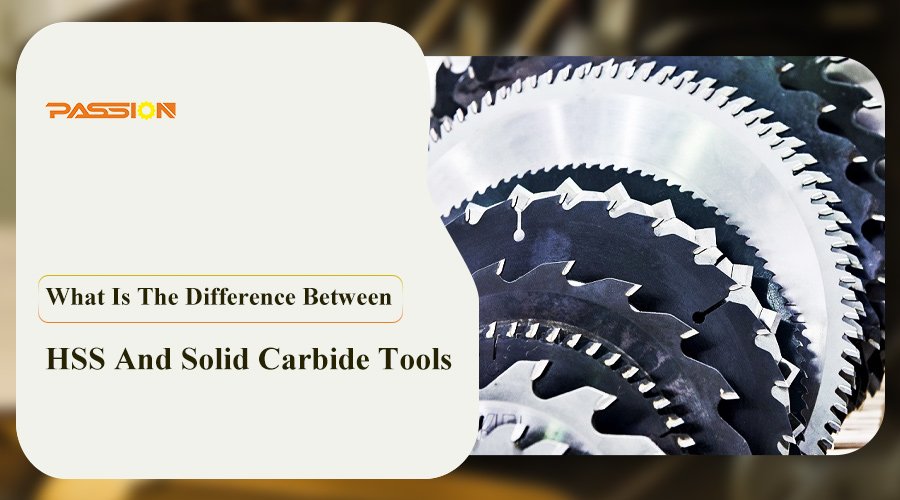Choosing The Right Tool Material
Picking the right tooling material is a big deal when you’re trying to get the most out of your industrial cutting operation. Whether you’re working with HSS (High-Speed Steel) or solid carbide tools, each material has its own pros and cons. Knowing what those are can help you make better decisions, save money on production, and make your tools last longer.
What Is The Main Difference Between HSS And Solid Carbide Tools?
The biggest difference between HSS and solid carbide tools is how long they last and how fast they go. HSS tools, or High-Speed Steel tools, are known for being cheap and versatile, staying sharp while being great for low-volume or flexible cutting. On the other hand, solid carbide tools are super hard and super fast, staying rigid and lasting a long time, making them perfect for high-volume work that’s really hard. HSS is forgiving and cheap, while carbide tools can take the heat and give you a nice, smooth finish when you need to go fast.
Choosing between the two depends largely on the specific project requirements, with each material excelling in distinct areas.
Which Is Better, Carbide Or HSS?
Pros And Cons Of HSS
HSS, or High-Speed Steel, is still a popular choice in a lot of industries because it’s cheap, versatile, and easy to sharpen. Here are some of the big advantages:
It’s Cheap: HSS tools generally cost less than carbide, so they’re great for low-volume or prototype projects.
You Can Sharpen It: Unlike carbide, you can sharpen HSS tools, so they’re more versatile and more forgiving in a manufacturing environment where you need to go fast, not perfect.
It’s Shock Resistant: HSS tools have a certain level of impact resistance, making them useful in applications where tool flexibility is required.
But HSS has some downsides, especially when you’re going fast or you’re working with hard materials. HSS doesn’t handle heat as well as carbide, so it wears out faster and doesn’t last as long when you’re cutting harder materials.
Pros And Cons Of Carbide
Solid carbide tools are known for being hard, rigid, and staying sharp at high speeds. Here are some of the big advantages:
It’s Hard: Carbide is a lot harder than HSS, so it stays sharp longer and can cut through harder stuff.
It’s Fast: Carbide tools are made to go fast, so they’re great for high-volume production where you need to get it done fast.
It Lasts Longer: Because it’s hard, carbide lasts longer than HSS, especially when you’re doing a lot of it all the time.
The downside to carbide is the price and the fact that it’s brittle. Carbide costs more than HSS, and it’s easy to chip or break because it’s so rigid when HSS might flex. That brittleness can limit where you can use carbide, especially if you need something that can take a lot of banging around.
How Do Carbide Cutting Tools Compare To High-Speed Steel Tools?
Carbide and HSS tools are different because of what they’re made of, and that means they have different levels of rigidity, cutting speed, and where they work best.
Rigidity And Cutting Speed
Carbide tools are known for being rigid, which means they don’t bend as much when you’re cutting with them. That makes them more precise when you’re machining. Because they’re rigid, carbide tools can go faster without messing up the surface finish, so they’re good for things like boring, milling, and high-precision drilling.
On the other hand, HSS tools can be used in a lot of different applications because they’re more versatile. They might not go as fast as carbide tools, but they’re good for general-purpose stuff, especially when you don’t have to go as fast.
Typical Applications
Carbide tools are used in industries where you need something that’s tough, precise, and can handle heat. You see them a lot in automotive, aerospace, and heavy machinery because they’re good for cutting through hard metals and alloys. HSS tools are used a lot in smaller shops and more versatile manufacturing environments where you’re working with a lot of different materials and doing custom stuff.
What Are The Disadvantages Of Carbide?
Carbide tools are great, but there are some things you should know about them before you buy.
It Costs More
Carbide tools cost more than HSS tools, which can be a problem if you’re a smaller shop or you don’t have a lot of money to spend. The higher price is worth it if you’re doing a lot of work and you don’t want to keep buying new tools all the time.
It’s Brittle
Carbide is rigid, which is good and bad. It’s good because it makes the tool more precise, but it’s bad because it makes the tool more brittle than HSS. If you’re doing something where the tool might get hit or you’re putting a lot of stress on it, carbide can chip, and that makes the tool not last as long. That’s why you see HSS used more when you need something that can flex and take a hit.
What Type Of Machine Is A Solid Carbide Drill Best Used On?
Because of their durability, precision, and ability to cut at high speeds, carbide drills are preferred in various heavy-duty industries. They’re especially suited to tasks that require sustained cutting on hard materials, making them the ideal choice for the following:
Construction: Carbide drills are highly effective for cutting through hard surfaces and materials encountered in construction, including concrete and steel.
Mining: Mining equipment often requires drills that can withstand abrasive materials. Carbide tools offer the toughness and longevity necessary for such rigorous use.
Agriculture: In agricultural machinery, where frequent cutting through dense materials is required, carbide tools provide the necessary endurance and efficiency.
Automotive and Aerospace: High-precision requirements in automotive and aerospace manufacturing make carbide drills essential for creating accurate and long-lasting components.
Because of these applications, carbide drills are typically used in machines that require high performance and have specific durability requirements.
How To Decide: When To Choose HSS VS. Solid Carbide Tools
Deciding between HSS and carbide tools ultimately depends on your project or industry. Here are some things to think about:
Budget
If budget is a primary concern and you’re not making a lot of parts, HSS is probably the way to go. It’s cheap, easy to sharpen, and can be used for a lot of different things. But if you’re making a lot of parts, the longer life and less downtime of carbide tool might be worth the extra money.
Application Volume And Material Type
If you’re making a lot of parts or you’re cutting hard, abrasive materials, carbide is the way to go. Industries like aerospace, automotive, and heavy manufacturing benefit from carbide’s ability to stand up to heat and wear for a long time. But if you’re changing tools a lot or cutting a lot of different materials, HSS is more flexible and cheaper.
Examples
Here are a few examples to help you understand what I’m talking about:
Example 1: Small Shop, Lots of Different Stuff
If you’re running a shop where you have to be able to do a lot of different things and you’re always changing materials or projects, HSS is the way to go. It’s versatile and easy to sharpen, so you can stay efficient.
Example 2: High-Precision, Lots of Parts
If you’re making a high-precision aerospace part that has to be really tough and you can’t afford to have your tools break or wear out all the time, carbide is the way to go. It’s heat resistant and hard, so your tools last longer and you don’t have to stop as often.
Example 3: Cost-Conscious, Low-Volume Prototyping
If you’re making prototypes and you’re worried about the cost and not so worried about the material, HSS is the way to go. It’s cheap and you can make a lot of parts without spending a lot of money.
The choice between HSS and carbide tools ultimately comes down to your specific operational needs, budget, and production volume. While HSS is cheap, flexible, and easy to maintain, carbide tools are the toughest, fastest, and most precise, which makes them great for high-stakes, high-volume applications.
If you’re a company or a workshop that needs high-quality, customizable industrial cutting tools, we have a whole bunch of options that meet the highest standards for durability and performance. Contact us today to find the best tools for your application and make your production more efficient.



